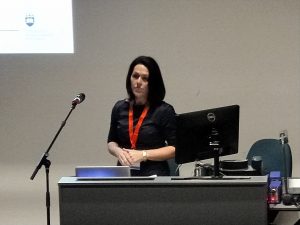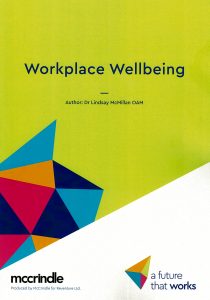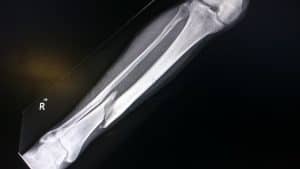 Rail-related suicides are tragedies that ripple throughout society affecting families of the suicides as well as the train drivers, their families and their colleagues. Various strategies are being trialled but often the results of interventions are hard to quantify. At the annual conference of the
Rail-related suicides are tragedies that ripple throughout society affecting families of the suicides as well as the train drivers, their families and their colleagues. Various strategies are being trialled but often the results of interventions are hard to quantify. At the annual conference of the
Category: psychiatric
New workplace wellbeing report is what it is
 Converge and Reventure launched their latest research report into workplace wellbeing on 23 November 2017. The report, not yet available online, is based round a survey of just over 1000 Australians comprising over 80% full-time or part-time employees, The report has been produced as a guide for businesses and may be of some interest to health and safety people but is of limited application.
Converge and Reventure launched their latest research report into workplace wellbeing on 23 November 2017. The report, not yet available online, is based round a survey of just over 1000 Australians comprising over 80% full-time or part-time employees, The report has been produced as a guide for businesses and may be of some interest to health and safety people but is of limited application.
Definition
Most research reports include a clear statement of the aim of the research or a definition of the concept being investigated.
New OHS statistics expand our understanding of work injuries and mental health
 On November 9 2017, the Australian Institute of Health and Welfare (AIHW) released statistical data on work-related injury. This data included statistics from workers compensation but also statistics about hospitalised injuries that were identified as work-related but funded by sources other than workers’ compensation. The report also provides a different perspective on mental health.
On November 9 2017, the Australian Institute of Health and Welfare (AIHW) released statistical data on work-related injury. This data included statistics from workers compensation but also statistics about hospitalised injuries that were identified as work-related but funded by sources other than workers’ compensation. The report also provides a different perspective on mental health.
What do Weinstein, Spacey and others have to do with OHS?
“Then I went, ‘Oh hang on, I’ve normalised so much of this as part of my industry…. This last three months has really made us all take a long hard look at what we have even let ourselves think is acceptable.” – Sacha Horler
Such a statement is familiar to those working in the field of occupational health and safety (OHS). This normalisation, or habituation, has underpinned much of the discussion of what builds a safety culture – “the way things are done round here”. As a result of revelations and accusations pertaining to Gary Glitter, Rolf Harris, Jimmy Saville, Robert Hughes, Harvey Weinstein, and Kevin Spacey, the entertainment industry around the world has been forced to assess the fundamental ethics on which sections of its industry are based. Continue reading “What do Weinstein, Spacey and others have to do with OHS?”
Look to the source of workplace conflict, exploitation and injustice
 Occupational health and safety advocates are pushing for safety management and strategies to refocus on people by talking about “people-centric” approaches and recalibrating legislation to re-emphasise prevention. This push parallels society’s frustration with political strategies that favour big business, the under-investment in education and health care systems and companies that announce record profits at the same time as sacking staff. That frustration is becoming accepted by political parties that are starting to apply more people-centric policies or by countries and States that are appointing representatives from outside the mainstream political organisations.
Occupational health and safety advocates are pushing for safety management and strategies to refocus on people by talking about “people-centric” approaches and recalibrating legislation to re-emphasise prevention. This push parallels society’s frustration with political strategies that favour big business, the under-investment in education and health care systems and companies that announce record profits at the same time as sacking staff. That frustration is becoming accepted by political parties that are starting to apply more people-centric policies or by countries and States that are appointing representatives from outside the mainstream political organisations.
At a closing event for National Safe Work Month on 1 November 2017, WorkSafe Victoria’s CEO,
Discussion of corporate culture includes OHS even when it doesn’t
 The political debate about the dysfunctional culture of Australia’s banking sector has diminished to a discussion, and that discussion continues to bubble along, mostly, in the Australian Financial Review (AFR). The discussion is important for the occupational health and safety (OHS) profession to watch as any change in safety management systems will occur within the corporate or organisational culture.
The political debate about the dysfunctional culture of Australia’s banking sector has diminished to a discussion, and that discussion continues to bubble along, mostly, in the Australian Financial Review (AFR). The discussion is important for the occupational health and safety (OHS) profession to watch as any change in safety management systems will occur within the corporate or organisational culture.
Two (possibly paywalled) articles appeared this week in the AFR – “
Workplace mental health and wellbeing strategies must consider suicide
 There is an increased blurring between the workplace, work and mental health. In the past, work and life were often split implying that one had little to do with the other except for a salary in return for effort and wellness in preparation for productiveness. This split was always shaky but was convenient for lots of reasons, one of which was the management of occupational health and safety (OHS). However that perceptual split is over, now that mental health has come to the fore in many OHS considerations.
There is an increased blurring between the workplace, work and mental health. In the past, work and life were often split implying that one had little to do with the other except for a salary in return for effort and wellness in preparation for productiveness. This split was always shaky but was convenient for lots of reasons, one of which was the management of occupational health and safety (OHS). However that perceptual split is over, now that mental health has come to the fore in many OHS considerations.
Recently

